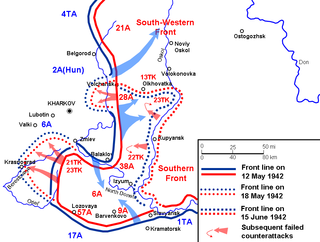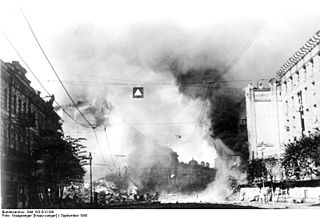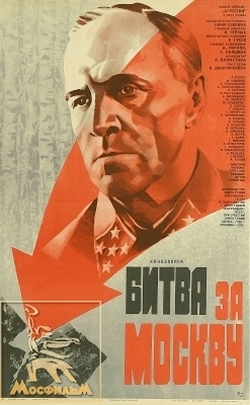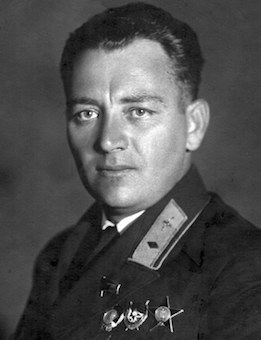| |||||
| Decades: | |||||
|---|---|---|---|---|---|
| See also: | |||||
The following lists events that happened during 1941 in the Union of Soviet Socialist Republics .
| |||||
| Decades: | |||||
|---|---|---|---|---|---|
| See also: | |||||
The following lists events that happened during 1941 in the Union of Soviet Socialist Republics .

Georgy Konstantinovich Zhukov was a Marshal of the Soviet Union. He also served as Chief of the General Staff, Minister of Defence, and was a member of the Presidium of the Communist Party. During World War II, Zhukov oversaw some of the Red Army's most decisive victories, after which he was appointed the military governor of the Soviet Occupation Zone in Germany.

Vyacheslav Mikhaylovich Molotov was a Russian and later Soviet politician and diplomat, an Old Bolshevik, and a leading figure in the Soviet government from the 1920s onward. He served as Chairman of the Council of People's Commissars from 1930 to 1941 and as Minister of Foreign Affairs from 1939 to 1949 and from 1953 to 1956. He is considered to be one of the greatest diplomats in history.
The Stavka is a name of the high command of the armed forces formerly used formerly in the Russian Empire and Soviet Union and currently in Ukraine.

Semyon Konstantinovich Timoshenko was a Soviet military commander, Marshal of the Soviet Union, and one of the most prominent Red Army commanders during the Second World War.

The Battle of Moscow was a military campaign that consisted of two periods of strategically significant fighting on a 600 km (370 mi) sector of the Eastern Front during World War II, between September 1941 and January 1942. The Soviet defensive effort frustrated Hitler's attack on Moscow, the capital and largest city of the Soviet Union. Moscow was one of the primary military and political objectives for Axis forces in their invasion of the Soviet Union.

Konstantin Konstantinovich Rokossovsky was a Soviet and Polish officer who became a Marshal of the Soviet Union, a Marshal of Poland, and served as Poland's Defence Minister from 1949 until his removal in 1956 during the Polish October. He became one of the most prominent Red Army commanders of World War II.

Rodion Yakovlevich Malinovsky was a Soviet military commander and Marshal of the Soviet Union. He served as Minister of Defence of the Soviet Union from 1957 to 1967, during which he oversaw the strengthening of the Soviet Army and helped build up the image of the Soviet Union as a military superpower.

The Second Battle of Kharkov or Operation Fredericus was an Axis counter-offensive in the region around Kharkov against the Red Army Izium bridgehead offensive conducted 12–28 May 1942, on the Eastern Front during World War II. Its objective was to eliminate the Izium bridgehead over Seversky Donets or the "Barvenkovo bulge" which was one of the Soviet offensive's staging areas. After a winter counter-offensive that drove German troops away from Moscow but depleted the Red Army's reserves, the Kharkov offensive was a new Soviet attempt to expand upon their strategic initiative, although it failed to secure a significant element of surprise.

The First Battle of Kiev was the German name for the major battle that resulted in an encirclement of Soviet troops in the vicinity of Kiev during World War II, the capital and most populous city of the Ukrainian Soviet Socialist Republic. This encirclement is the largest encirclement in the history of warfare by number of troops. The battle occurred from 7 July to 26 September 1941 as part of Operation Barbarossa, the Axis invasion of the Soviet Union.

The Battles of Rzhev were a series of Red Army offensives against the Wehrmacht between 8 January 1942 and 31 March 1943, on the Eastern Front of World War II. The battles took place in the northeast of Smolensk Oblast and the south of Tver Oblast, in and around the salient surrounding Rzhev. Due to the high losses suffered by the Soviet Army, the campaign became known by veterans and historians as the "Rzhev Meat Grinder".

The Western Front was a front of the Red Army, one of the Red Army Fronts during World War II.
As a result of the Soviet invasion of Poland in 1939, hundreds of thousands of Polish soldiers became prisoners of war. Many of them were executed; 22,000 Polish military personnel and civilians perished in the Katyn massacre alone.

The Battle of Moscow is a 1985 Soviet two-part war film, presenting a dramatized account of the 1941 Battle of Moscow and the events preceding it. The films were a Soviet-East German-Czechoslovak-Vietnamese co-production directed by Yuri Ozerov who also wrote the script. It was made in time for the 40th anniversary of the Allied victory over Nazi Germany and the 20th anniversary of the proclamation of the Victory Day holiday and Moscow's declaration as a Hero City.

Stalingrad is a 1990 two-part war film written and directed by Yuri Ozerov, and produced by Quincy Jones and Clarence Avant. Revolving around the eponymous Battle of Stalingrad, the film was a co-production between the Soviet Union and East Germany. It stars an ensemble cast featuring Powers Boothe, Mikhail Ulyanov, Bruno Freindlich, Fernando Allende, Sergei Garmash, Nikolai Kryuchkov, and Ronald Lacey.

Georgy Maximilianovich Malenkov was a Soviet politician who briefly succeeded Joseph Stalin as the leader of the Soviet Union. However, at the insistence of the rest of the Presidium, he relinquished control over the party apparatus in exchange for remaining Premier and first among equals within the Soviet collective leadership. He then became embroiled in a power struggle with Nikita Khrushchev that culminated in his removal from the premiership in 1955 as well as the Presidium in 1957.
The following lists events that happened during 1939 in the Union of Soviet Socialist Republics.
The following lists events that happened during 1935 in the Union of Soviet Socialist Republics.

Ivan Iosifovich Proskurov was a Soviet pilot and recipient of the title Hero of the Soviet Union, best known as the chief of military intelligence who tried in vain to warn Joseph Stalin that the Red Army was ill-prepared to defend the USSR against a German invasion - unwelcome advice which apparently cost him his life.

The Stavka of the Supreme High Command was an extraordinary body of the highest military command, exercising strategic leadership of the Soviet Armed Forces during the Great Patriotic War.

The German declaration of war on the Soviet Union, officially Note of the Ministry of Foreign Affairs of Germany to the Soviet government from 21 June 1941, is a diplomatic note presented by German Foreign Minister Joachim von Ribbentrop to Soviet ambassador Vladimir Dekanozov in Berlin on 22 June 1941 at 4 a.m. local time, informing him about the German invasion of the Soviet Union during World War II and preceding casus belli. Later in the morning of that day German ambassador to the Soviet Union Friedrich-Werner Graf von der Schulenburg presented the note to Soviet Foreign Minister Vyacheslav Molotov in Moscow. On the same day The New York Times published an abridged English translation of the declaration.